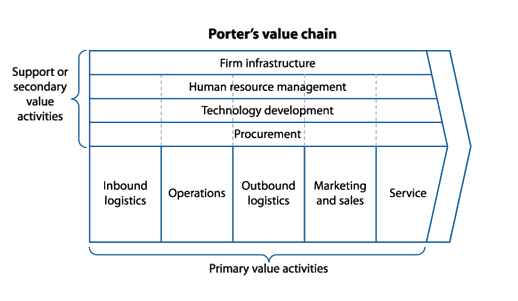Businesses require advanced tools that aid them to examine complicated systems that include costs, factors, and more. But, how do certain companies evaluate and gain a competitive advantage over their competitors?
Value Chain Analysis— is the answer to that question. It helps decision-makers to analyze each business segment separately and also assists them to streamline procedures and enhance revenues.

In this detailed guide, we will go through all concepts associated with Value Chain Analysis. Take a deeper look at what we’ll cover ahead:
- Understanding Value Chain Analysis.
- Components of Value Chain Analysis.
- Use of Value Chain Analysis.
- Benefits of Value Chain Analysis.
- 5 Best Approaches to Build a Value Chain Analysis.
- Templates of Value Chain Analysis.
Understanding Value Chain Analysis
Michael Porter, a Harvard Business School professor, created the phrase— value chain analysis in 1985. His book — ‘Competitive Advantage’— developed the basic notion, laying out how companies might identify primary and supporting activities and produce value for their consumers.
Let’s understand Value Chain Analysis:
A value chain analysis is a method for analyzing and improving the efficiency of a company's costs and departments.
Furthermore, it forces you to analyze how each step contributes to or detracts from the value of your end product or service. In addition, you can use this information to obtain a competitive advantage, increase efficiency, and enhance profit margins. As a result, you may be able to gain:
- Cost savings are achieved by making each operation in the value chain more efficient and thus less costly.
- Product differentiation can be achieved by devoting more time and resources to tasks such as research and development, design, and marketing.
Components of Value Chain Analysis
According to Porter’s definition, all of the activities that make up a business must divide the value chain into two tiers in order to conduct a value chain analysis:
- Primary activities.
- Secondary activities.
Primary activities are those that contribute directly to the production of a product or the delivery of a service. It includes:
Inbound Logistics
Inbound logistics includes receiving, inventory management, warehousing of source goods and components.
Outbound Logistics
Outbound logistics refers to distribution-related activities such as packaging, sorting, and shipping.
Operations
Raw materials and components are turned into a completed product through operations.
Marketing and Sales
Marketing and sales activities include a promotion, advertising, and pricing strategy, all of which are relevant to the marketing and sale of a product or service.
Service
After-sales services include things like installation, training, quality assurance, repair, and customer service.
Secondary activities are divided into the following categories to help primary operations become more efficient, hence creating competitive advantage:
Procurement
The operations involved in purchasing raw components, materials, equipment, and services are referred to as procurement.
Technological Advancement
Product design, market research, and process development come under technological advancements activities.
Human Resource Management
Employee recruitment, hiring, training, development, retention, and remuneration are all part of human resources management.
Firm Infrastructure
Infrastructure covers tasks connected to the company's overhead and management, such as fundraising and planning.
Use of Value Chain Analysis
There are two methods for doing the analysis, depending on the type of competitive advantage a company wishes to achieve.
Businesses have two kinds of competitive advantages. It includes — cost advantage and differentiation advantage.
Let's have a look at these in more detail below.
Value chain analysis is primarily used to identify value gaps in your processes, products, and services. By implementing this method you'll employ to improve your product's relevance, reduce the volume of changes, and increase profit margins.
In addition, you can carve out your competitive edge and set measurable targets that fit with your desired outcome at this point.
Eventually, you'll have a detailed understanding of your company's objectives and how you intend to deliver value.
Benefits of Value Chain Analysis
A value chain analysis can benefit a company in a number of ways:
- Gains in efficiency: It can help a company become more efficient by identifying areas where it might save money.
- Create or enhance competitive advantage: This analysis aids in demonstrating performance differences between a company and its competitors because it allows comparison in specific areas. It might also point up areas where you can improve.
- Help with strategic planning: This study aids strategic planning by revealing which areas bring the most value to the firm.
- Articulate the precise value that the company generates: This study can indicate where a corporation generates value and where it loses money, allowing decision-makers to quantify both.
Five Best Approaches to Building a Value Chain Analysis
We’ve discussed the five methods that will help you to build a value chain analysis. Let’s check:
Method 1: Identify all activities in the value chain
The first and foremost method is to identify all activities associated with the building of your company’s product. It further includes all departments of your company. Here’s an example for your reference. Check out:
Suppose, you have to work and analyze the product design team of your company. Then, you can check and inquire about the following questions:
- What’s the size of your product team design?
- What are the raw elements they're working with?
- How much does each team require to fulfill their activities?
Take this example for your reference and do the same for all other departments of your company. Once you define them on primary activity, then start with your analysis to understand all aspects in detail.
Note: It is obvious that this stage might take a long time and, if feasible, should not be done by one person. Therefore, you need to promote internal cross-collaboration so that each department may detail its operating costs, logistics, and services.
Furthermore, make use of a task management system software while identifying each step in your value chain. You can use Asana or Trello that can help you to keep each activity organized and produce a visual chart.
Method 2: Calculate the cost of each value chain activity
When estimating contribution costs, remember to include costs such as utilities, rent, staffing, and other elements. Moreover, doing this would make your work easy to see how much revenue you're actually making when you have an exact view of every single cost.
After you've mapped out each action, you can figure out which areas of your value chain are costing your company the most money.
Once you obtain and figure out that information, then move to the following steps:
- Try to renegotiate the lease if you wish to save money on rent. However, if you fail in that attempt, then you can shift to a less expensive place. It may help you to increase your profit margin.
- If you wish to save money on personnel, then you may look at how many workers are planned per shift and possibly reduce staff hours during slower periods.
- If you are unable to streamline processes or reduce expenses in any manner, then you may try to increase their perceived worth. They could do so by developing and promoting distinctive products, or by acquiring new elements that will help to boost sales or engagement.
Ultimately, you may find it easy to understand how precise, comprehensive calculations may make or break your value chain's efficacy.
Method 3: Closer Observation on Customer’s Perception
Customer perception has a significant impact on product margins. Moreover, customers usually prefer branded products over non-branded ones. Also, customers tend to pay more money when it comes to branded products.
Therefore, you need to delve into your clients' minds to identify what they consider valuable. In addition, you can detect statistical patterns in your customers' purchase behavior by collecting quantitative and qualitative data.
Furthermore, analyzing and identifying these characteristics can also aid your sales personnel in prospecting and qualifying suitable consumers down the road. Understanding your consumers' intent and what they consider valuable is the key to understanding why and how they make purchasing decisions.
You must be aware of the fact that people frequently base their decisions on the actions of their friends, family, and intimate social groupings. Moreover, knowing what your customers and their social ecosystem want can help you offer your product in a way that will inspire them to buy it.
Method 4: Examine the value chains of your competitors.
Market analysis is the most effective method for determining value. If you don't have access to your competitors' infrastructure and operational breakdowns, you can use benchmarks as a starting point. Competitive benchmarking is the term for this method.
Competitive benchmarking can be implemented in one of three following approaches:
- Strategic benchmarking: It is the process of comparing your high-level company strategy to that of your competitors to see what makes them successful.
- Process benchmarking: It is the process of comparing your process structure and operations to those of your competitors.
- Performance Benchmarking: It is the method of comparing and contrasting outcomes. It includes factors such as organic traffic, social media performance, revenue, reviews and ratings, and more.
Furthermore, you need to first identify your competitive benchmarking goals before conducting research, comparing, and determining value.
You can determine whether your spending is excessive by analyzing the rough costs of your competitors' online sales and marketing initiatives.
To gain insight into your competitors' strategic planning and decision-making processes, McKinsey proposes employing a competitor-insight loop:
Moreover, make use of competitors’ frontline personnel to obtain the relevant and latest information and data to discover value gaps. You can use competition’s blogs or shared databases in that case.
Method 5: Make a decision about competitive advantage
At this point, you’ll have a good and clear idea of certain factors. It includes — your internal costs, what adjustments you can make, and how they compare to your competitors at this point.
Furthermore, if you pick a cost advantage, then you must discover a means to optimize and reduce the costs of your value chain's primary and supporting operations.
Moreover, you may decide to outsource expertise, automate specific human tasks, or seek out lower-cost delivery options. In addition, as more individuals work from home, you may be able to eliminate the need for office space.
Eventually, any cost savings you make in the supply chain will reduce the price of your final product. In simple words, the lower you can get your product prices, the bigger your cost advantage over competitors will be.
On the other hand, if you select competitive differentiation, then you should focus on raising the perceived value of the things that your customers are most willing to pay for.
Moreover, by recognizing your clients' most basic demands and needs and placing your products as the ultimate solution, you may provide their most basic requirements and needs.
For example, during the sales pitch or closing step of the funnel, your sales team can showcase your product distinction by:
- Outlining the distinct advantages your product offers that your competitors' products do not.
- Include a list of other companies in the prospect's industry that have used and valued your product or service.
- Showcasing a client case study that supports your argument and highlights significant data or ROI.
Templates of Value Chain Analysis
Following is the list of some examples/templates of value chain analysis. Have a look:
Template for Academic/Educational Institutions
Rather than the acts that go into manufacturing a commodity or service, this model looks at the value chain involved in establishing academic research.
Templates for Cost Profit Margin
This template is for you if you're looking to compare the cost of your primary and support operations to the predicted profit margin.
Porter’s Value Chain Analysis Model
This Porter's value chain analysis template gives you a broad perspective of your company's operations.
Template For Products
Use this template to examine the steps involved in producing a product, from raw materials to completed goods.
How Deskera Can Assist You?
To run a successful business, you must ensure to have a strong foundation of value chain analysis. Although, there are tons of duties and responsibilities that you have to fulfill. Among those responsibilities, you also have to focus on value chain analysis. And, without any doubt, your time is essential and has to be saved at all costs to develop your business further. This can be ensured with the Deskera system.
Doing so will help you to save the time taken in transferring customer data between the different systems. It will also assist you with real-time updates about your business like cash flow status, customer satisfaction, inventory management, sales, purchases, purchase orders, customer tickets, customer satisfaction, managing leads, revenues, profit, and loss statements, and balance sheets.
Moreover, it would also help in integrating sales methodology across different platforms onto one system so that you have a consolidated list for email campaigns, leads management, and sales pipeline to mention a few.
It will also help you to sync between your orders, payments, taxes, refunds, product variants, sending out invoices and reminders, facilitating invoice management, and even undertaking follow-ups and advertisement campaigns.
Such a consolidated platform will help you to improve your sales through building an effective b and also facilitate faster and well-informed decision-making. It will help you in strengthening your opportunities and being braced for the threats.
Deskera books and Deskera CRM will also be able to ensure the highest customer satisfaction and thereby an increase in net revenues and net profits.
Final Takeaways
We have summarized all crucial key pointers for your reference. Let's take a closer look:
- A value chain analysis is a method for analyzing and improving the efficiency of a company's costs and departments.
- According to Porter’s definition, all of the activities that make up a business must divide the value chain into two tiers in order to conduct a value chain analysis: Primary activities and Secondary activities
- Businesses have two kinds of competitive advantages. It includes — cost advantage and differentiation advantage.
- The first and foremost method is to identify all activities associated with the building of your company’s product.
- When estimating contribution costs, remember to include costs such as utilities, rent, staffing, and other elements.
- Customer perception has a significant impact on product margins.
- You need to first identify your competitive benchmarking goals before conducting research, comparing, and determining value.
- If you pick a cost advantage, then you must discover a means to optimize and reduce the costs of your value chain's primary and supporting operations.
Related Articles













